Carrots are not just crunchy delights in salads or perfect for snacking; they’re also surprisingly easy to grow organically right in your backyard! Whether you’re a gardening enthusiast or just starting out, cultivating carrots organically can be a rewarding experience. This guide will walk you through everything you need to know to grow these vibrant veggies in a way that’s good for you and the environment.
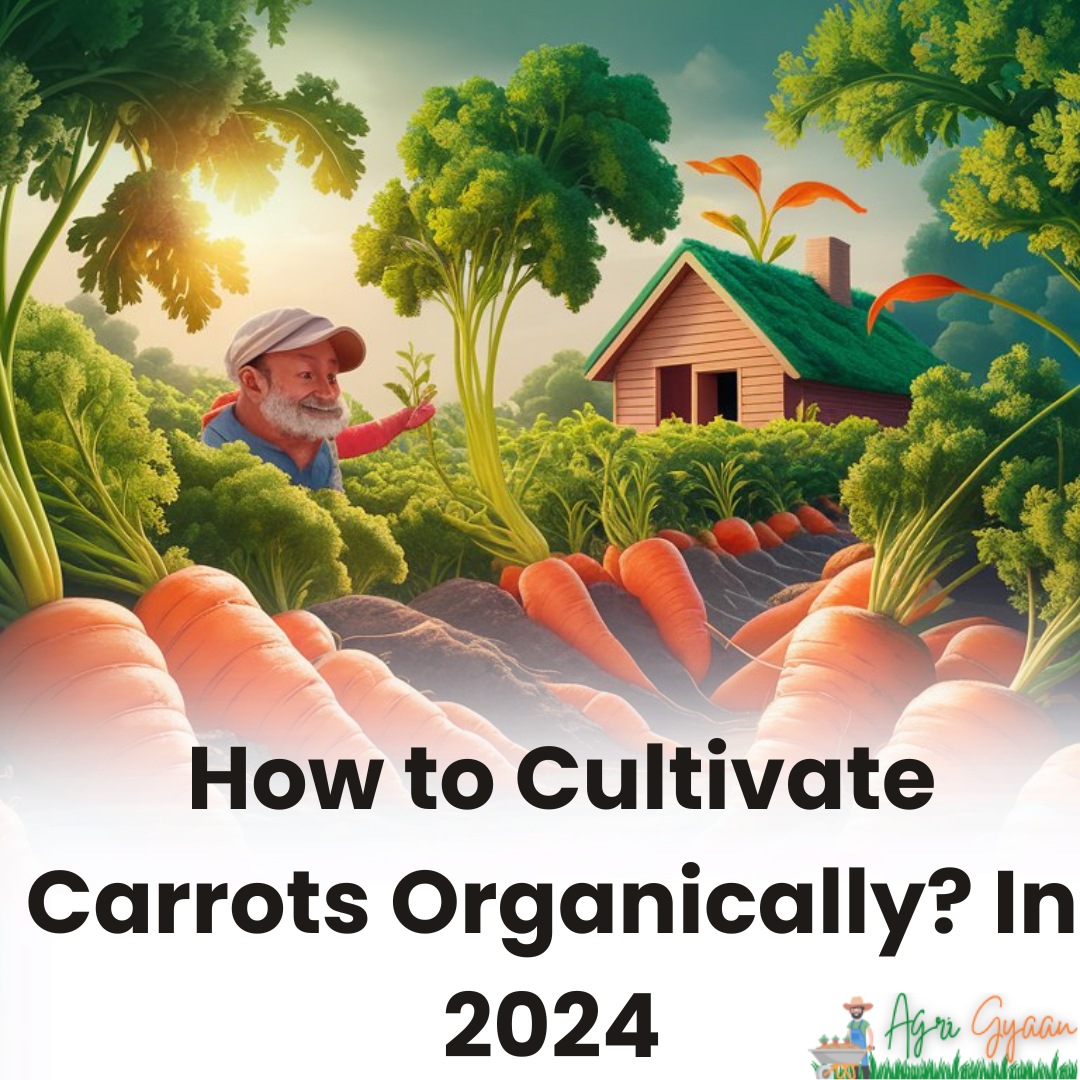
Understanding Organic Carrot Cultivation
1. Introduction to Organic Carrot Cultivation
Organic carrot cultivation focuses on growing carrots without synthetic fertilizers, pesticides, or genetically modified organisms (GMOs). This method promotes biodiversity, soil health, and ecological balance.
2. Soil Preparation
– Soil Type: Carrots thrive in loose, well-drained soil with a pH between 6.0 and 6.8. Avoid rocky or heavy clay soils.
– Soil Amendments: Incorporate organic matter like compost or well-rotted manure to improve soil structure and fertility.
– Tilling: Deep tilling helps loosen the soil, allowing carrots to grow straight and long.
3. Seed Selection and Sowing
– Varieties: Choose carrot varieties suitable for your climate and soil. Common types include Nantes, Imperator, and Chantenay.
– Seed Quality: Use certified organic seeds to ensure compliance with organic standards.
– Sowing Time: Sow seeds in early spring or late summer for fall harvest. Carrots require 70-80 days to mature.
– Planting Depth: Sow seeds 1/4 inch deep, spacing them 1-2 inches apart in rows 12-18 inches apart.
4. Watering and Irrigation
– Consistent Moisture: Keep the soil consistently moist, especially during germination and root development. Avoid waterlogging.
– Irrigation Methods: Drip irrigation is ideal for conserving water and minimizing weed growth.
5. Weed Management
– Mulching: Apply organic mulch like straw or grass clippings to suppress weeds, retain moisture, and regulate soil temperature.
– Hand Weeding: Regular hand weeding helps prevent weed competition, especially in the early stages of carrot growth.
6. Pest and Disease Control
– Companion Planting: Plant carrots alongside onions, leeks, or garlic to deter pests like carrot flies.
– Biological Controls: Use beneficial insects such as ladybugs and nematodes to control aphids and root-knot nematodes.
– Crop Rotation: Rotate carrots with non-root crops to reduce pest and disease buildup in the soil.
7. Nutrient Management
– Organic Fertilizers: Use organic fertilizers like compost tea, fish emulsion, or seaweed extract to provide essential nutrients.
– Soil Testing: Conduct soil tests to monitor nutrient levels and adjust fertilization practices accordingly.
Choosing the Right Carrot Varieties

Selecting the appropriate carrot variety for your garden depends on several factors including climate, soil type, intended use, and growing season. Here is a guide to help you choose the right carrot varieties:
1. Carrot Types by Shape and Size
– Nantes: These are cylindrical, with blunt tips and a sweet flavor. They are ideal for fresh eating and juicing. Nantes carrots are about 6-7 inches long and grow well in loose, sandy soils.
– Imperator: Known for their long, tapered shape, these carrots can reach up to 10 inches in length. They are the classic supermarket carrot, often used for their crisp texture and sweet taste. Imperators prefer deep, well-drained soils.
– Chantenay: These are shorter, conical carrots, typically around 5-6 inches long. They are well-suited for heavy or clay soils where longer varieties might struggle. Chantenay carrots are great for cooking and storage.
– Danvers: This type is a good all-purpose carrot, with a tapered shape that is shorter and more robust than Imperator varieties. Danvers carrots are about 6-8 inches long and are known for their adaptability to different soil types.
– Ball or Mini: These small, round carrots, such as ‘Paris Market’ or ‘Thumbelina’, are perfect for shallow soils or container gardening. They are often sweet and tender, ideal for snacking and salads.
2. Carrot Varieties by Growing Season
– Early Varieties: Early-maturing carrots like ‘Nantes Early’ and ‘Little Finger’ can be harvested in as little as 60-70 days. They are perfect for early spring planting or fall harvesting.
– Main-Season Varieties: These take longer to mature, usually between 75-85 days. Examples include ‘Danvers Half Long’ and ‘Chantenay Red Core’. They are suitable for mid-season planting.
– Storage Varieties: Late-maturing carrots like ‘Autumn King’ and ‘Berlicum’ are ideal for winter storage. They can be left in the ground longer to develop their full flavor and size, maturing in 90-100 days.
3. Carrot Varieties by Climate
– Cool Climates: Varieties like ‘Scarlet Nantes’ and ‘Bolero’ thrive in cooler temperatures and are less likely to bolt (go to seed) prematurely.
– Warm Climates: Heat-tolerant varieties such as ‘Tendersweet’ and ‘Red Cored Chantenay’ can handle higher temperatures without sacrificing quality.
4. Specialty Carrot Varieties
– Heirloom Varieties: These include ‘Purple Dragon’, ‘Cosmic Purple’, and ‘Yellowstone’. They offer unique colors and flavors, often with historical significance.
– Baby Carrots: Varieties like ‘Adelaide’ and ‘Atlas’ are specifically bred to be harvested young as true baby carrots, rather than the processed versions often found in stores.
– Coreless Varieties: Types like ‘Napa’ and ‘Ingot’ are bred to have minimal or no core, offering a more uniform texture and flavor throughout the carrot.
5. Organic and Disease-Resistant Varieties
– Organic Seeds: Look for certified organic seeds to ensure they meet organic growing standards. Examples include ‘Mokum’ and ‘Yaya’.
– Disease Resistance: Varieties like ‘Bolero’ and ‘Romance’ are bred for resistance to common carrot diseases such as Alternaria leaf blight and Pythium root dieback.
Selecting a Suitable Location

Choosing the right location for growing carrots is crucial to ensure healthy growth and a bountiful harvest. Here are key considerations for selecting a suitable site:
1. Sunlight
– Full Sun: Carrots require full sun to grow optimally. Ensure the location receives at least 6-8 hours of direct sunlight daily.
– Partial Shade: In hotter climates, partial shade during the peak afternoon hours can help prevent the soil from drying out too quickly.
2. Soil Requirements
– Soil Type: Loose, well-drained sandy or loamy soil is ideal for carrot cultivation. Heavy clay or rocky soils can lead to misshapen roots.
– Soil Depth: Carrots need deep, loose soil to develop long, straight roots. Ensure the soil is at least 12 inches deep for standard varieties.
– pH Level: Carrots thrive in slightly acidic to neutral soil with a pH of 6.0 to 6.8. Test the soil and amend it if necessary.
3. Soil Preparation
– Organic Matter: Incorporate plenty of organic matter, such as compost or well-rotted manure, to improve soil structure and fertility.
– Tillage: Thoroughly till the soil to break up any compacted layers and remove stones or debris that could impede root growth.
4. Water Availability
– Consistent Moisture: Carrots require consistent moisture, especially during germination and root development. Choose a location with easy access to a reliable water source.
– Irrigation System: Consider installing a drip irrigation system to provide even moisture and reduce the risk of fungal diseases.
5. Air Circulation
– Good Airflow: Ensure the location has good air circulation to prevent fungal diseases and promote healthy plant growth.
– Shelter from Wind: While airflow is essential, excessive wind can dry out the soil and damage young seedlings. Select a site that is sheltered from strong winds.
6. Previous Crops
– Crop Rotation: Avoid planting carrots in soil where other root vegetables (e.g., potatoes, beets) were grown in the previous two years to reduce the risk of soil-borne diseases and pests.
– Legumes Preceding Carrots: Planting carrots after legumes (e.g., peas, beans) can be beneficial, as legumes fix nitrogen in the soil, enriching it for the subsequent carrot crop.
7. Space and Layout
– Row Spacing: Plan your garden layout with adequate spacing. Carrot rows should be spaced 12-18 inches apart to allow for proper growth and ease of access for weeding and harvesting.
– Companion Planting: Consider companion planting with crops that benefit carrots, such as onions, leeks, and garlic, which can help deter pests.
8. Climate Considerations
– Local Climate: Choose a site that aligns with your local climate conditions. Carrots grow best in cooler temperatures (60-70°F/15-21°C) but can adapt to various climates with appropriate care.
– Frost Protection: In regions with frost, select a location that can be easily covered or protected during unexpected cold spells, especially in the early spring or late fall.
Soil Preparation for Carrot Cultivation

Proper soil preparation is essential for growing healthy and well-formed carrots. Here are the steps to prepare your soil for carrot cultivation:
1. Soil Testing
– pH Level: Test the soil pH to ensure it is between 6.0 and 6.8. Amend the soil if necessary to achieve the ideal pH range.
– Nutrient Levels: Conduct a soil test to determine the levels of essential nutrients such as nitrogen, phosphorus, and potassium. Based on the results, you can adjust the soil fertility.
2. Removing Debris and Weeds
– Debris Clearance: Clear the soil of any rocks, sticks, and other debris that could obstruct carrot growth or cause root deformation.
– Weed Removal: Remove all weeds from the planting area to reduce competition for nutrients and water. Consider using organic mulch to suppress weed growth.
3. Loosening the Soil
– Tilling: Deeply till the soil to a depth of at least 12 inches to ensure it is loose and friable. This helps carrots grow straight and long without encountering resistance.
– Double Digging: In areas with compacted soil, consider double digging. This involves removing the topsoil, loosening the subsoil, and then replacing the topsoil. This method enhances soil structure and root penetration.
4. Improving Soil Structure
– Organic Matter: Incorporate organic matter such as compost, well-rotted manure, or leaf mold into the soil. This improves soil structure, drainage, and nutrient content.
– Sand Addition: If you have heavy clay soil, adding sand can help improve drainage and soil aeration. Mix it thoroughly with the existing soil.
5. Nutrient Enrichment
– Balanced Fertilizer: Apply a balanced organic fertilizer according to the soil test results. Avoid high-nitrogen fertilizers as they can promote excessive foliage growth at the expense of root development.
– Compost: Adding compost enriches the soil with nutrients and beneficial microorganisms, enhancing overall soil health.
6. Fine-Tuning Soil Texture
– Raking: After tilling and amending the soil, rake it to create a smooth, fine-textured surface. This is crucial for small carrot seeds to germinate and establish properly.
– Raised Beds: Consider using raised beds, especially if your garden has poor drainage. Raised beds improve soil drainage, aeration, and temperature control.
7. Moisture Management
– Moisture Retention: Ensure the soil is evenly moist but not waterlogged. Consistent moisture is vital for seed germination and root development.
– Mulching: Apply a thin layer of organic mulch, such as straw or grass clippings, to retain soil moisture and regulate temperature.
8. Pre-Sowing Preparation
– Soil Settlement: Prepare the soil a few weeks before sowing to allow it to settle. This helps avoid uneven soil levels that can impact carrot growth.
– Marking Rows: Use a garden hoe or string to mark straight rows, ensuring proper spacing for carrot seeds.
Planting Carrot Seeds
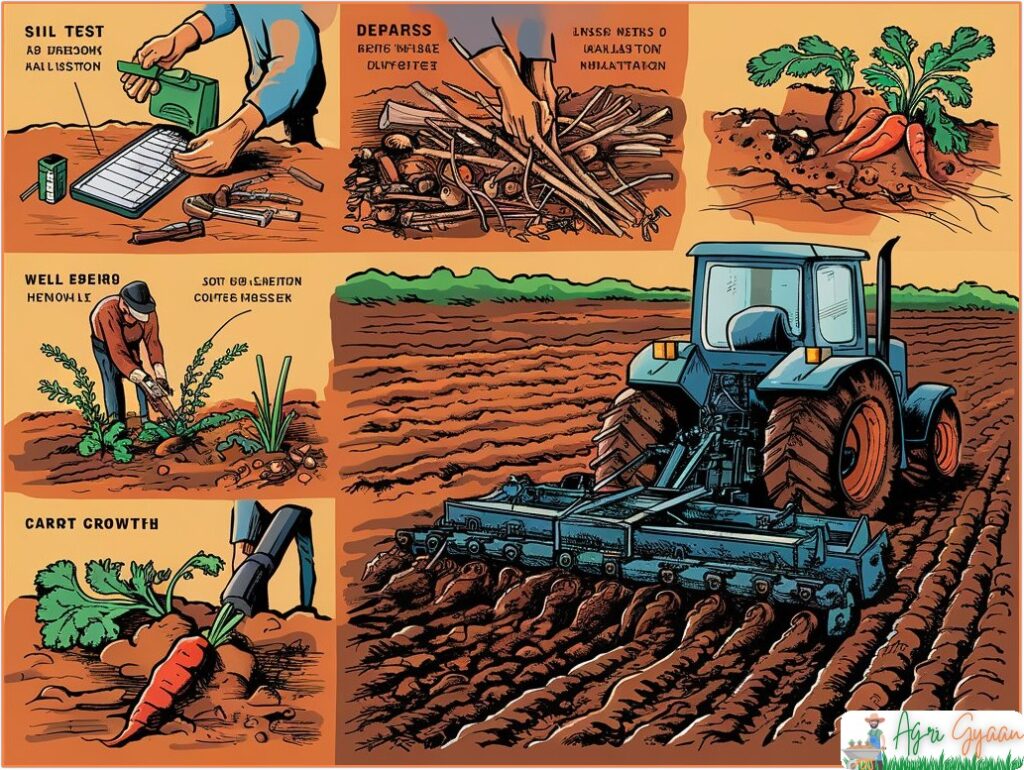
Proper planting techniques are crucial for the successful germination and growth of carrot seeds. Here are the steps to plant carrot seeds effectively:
1. Timing
– Spring Planting: Sow carrot seeds in early spring, 2-3 weeks before the last expected frost date.
– Fall Planting: For a fall harvest, plant carrot seeds 10-12 weeks before the first expected frost date in autumn.
2. Seed Selection
– Variety Choice: Choose carrot varieties suited to your climate and soil conditions. Consider factors like root length, maturity time, and disease resistance.
– Certified Organic Seeds: Opt for certified organic seeds to comply with organic growing standards.
3. Soil Preparation
– Fine Seed Bed: Ensure the soil is well-prepared, loose, and free from clumps and debris. Rake the soil to create a smooth surface.
– Moisture Level: Moisten the soil lightly before planting, ensuring it is damp but not waterlogged.
4. Sowing Seeds
– Row Spacing: Mark rows 12-18 inches apart using a garden hoe or string line.
– Seed Depth: Sow carrot seeds 1/4 inch deep. Carrot seeds are small and should be planted shallowly.
– Seed Spacing: Space seeds 1-2 inches apart within the row. For easier handling, mix seeds with sand to ensure even distribution.
– Succession Planting: Sow seeds every 2-3 weeks for a continuous harvest throughout the growing season.
5. Covering Seeds
– Soil Cover: Lightly cover the seeds with a fine layer of soil or compost, about 1/4 inch thick.
– Gently Firm: Gently firm the soil over the seeds using your hands or a light garden tool to ensure good seed-to-soil contact.
6. Watering
– Initial Watering: Water the planted area gently but thoroughly to keep the soil evenly moist, aiding seed germination.
– Consistent Moisture: Maintain consistent moisture throughout the germination period. Avoid letting the soil dry out completely, but do not overwater.
7. Germination Period
– Germination Time: Carrot seeds typically take 10-21 days to germinate, depending on soil temperature and moisture.
– Row Covers: Use row covers to protect young seedlings from pests and retain soil moisture.
8. Thinning
– First Thinning: Once seedlings are 1-2 inches tall, thin them to 2-3 inches apart to allow adequate space for root development.
– Final Thinning: Thin again as needed to maintain a spacing of 3-4 inches between plants.
Watering Techniques
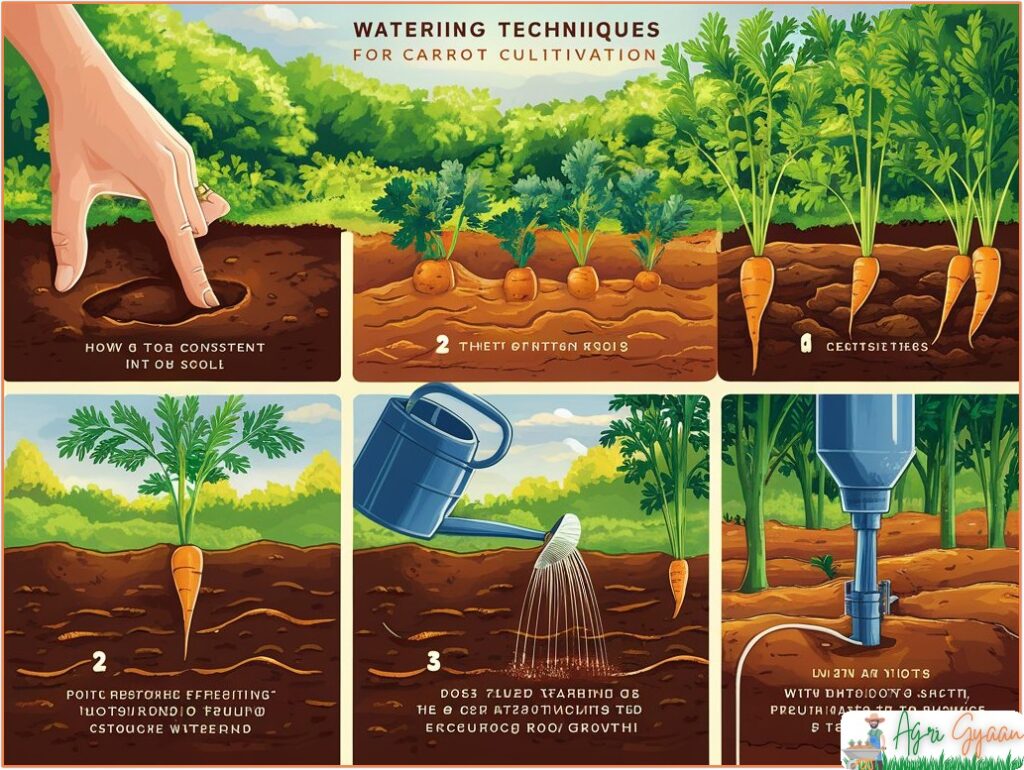
Proper watering is crucial for the successful growth of carrots. Here are some effective watering techniques to ensure your carrot crop thrives:
1. Soil Moisture Monitoring
– Consistent Moisture: Carrots require consistent soil moisture, especially during germination and early growth stages. The soil should remain evenly moist but not waterlogged.
– Soil Check: Check the soil moisture regularly by inserting your finger or a moisture meter into the soil. The top inch of soil should feel damp but not soggy.
2. Watering Frequency
– Germination Phase: Water the soil lightly and frequently during the germination period (10-21 days) to keep it consistently moist. Avoid heavy watering that can displace seeds.
– Post-Germination: Once the seedlings have emerged, reduce the frequency but increase the depth of watering to encourage deep root growth. Water deeply once or twice a week, depending on rainfall and soil conditions.
3. Watering Methods
– Drip Irrigation: Drip irrigation is an efficient method for watering carrots. It delivers water directly to the root zone, reducing water waste and minimizing the risk of fungal diseases.
– Soaker Hoses: Soaker hoses can be used to provide slow, even watering along the rows. Lay the hoses close to the base of the plants to ensure water reaches the root zone.
– Hand Watering: If using a watering can or hose, apply water gently to avoid washing away seeds or compacting the soil. Use a nozzle with a fine spray setting to distribute water evenly.
4. Mulching
– Organic Mulch: Apply a layer of organic mulch, such as straw, grass clippings, or shredded leaves, around the carrot plants. Mulch helps retain soil moisture, regulate soil temperature, and reduce weed competition.
– Avoiding Direct Contact: Ensure mulch does not directly touch the carrot seedlings to prevent rot and disease. Maintain a small gap around the base of each plant.
5. Avoiding Overwatering
– Waterlogging Prevention: Avoid overwatering, as waterlogged soil can lead to root rot and other diseases. Ensure the soil has good drainage to prevent standing water.
– Watering Schedule Adjustment: Adjust your watering schedule based on weather conditions. During periods of heavy rainfall, reduce or pause supplemental watering to prevent overwatering.
6. Timing
– Morning Watering: Water your carrots early in the morning to allow the foliage to dry during the day, reducing the risk of fungal diseases.
– Avoid Evening Watering: Avoid watering in the evening, as prolonged moisture on the foliage can promote disease development.
7. Watering Depth
– Deep Watering: Encourage deep root growth by watering deeply. This means applying enough water to moisten the soil to a depth of at least 6-8 inches.
– Shallow Watering: Avoid shallow, frequent watering, as this can lead to shallow root systems and weaker plants.
8. Drought Stress Management
– Monitoring for Stress: Monitor your carrot plants for signs of drought stress, such as wilting, yellowing leaves, or stunted growth. Adjust your watering practices accordingly.
– Supplemental Watering: During hot, dry periods, provide additional watering to maintain consistent soil moisture and prevent stress on the plants.
Fertilizing Naturally
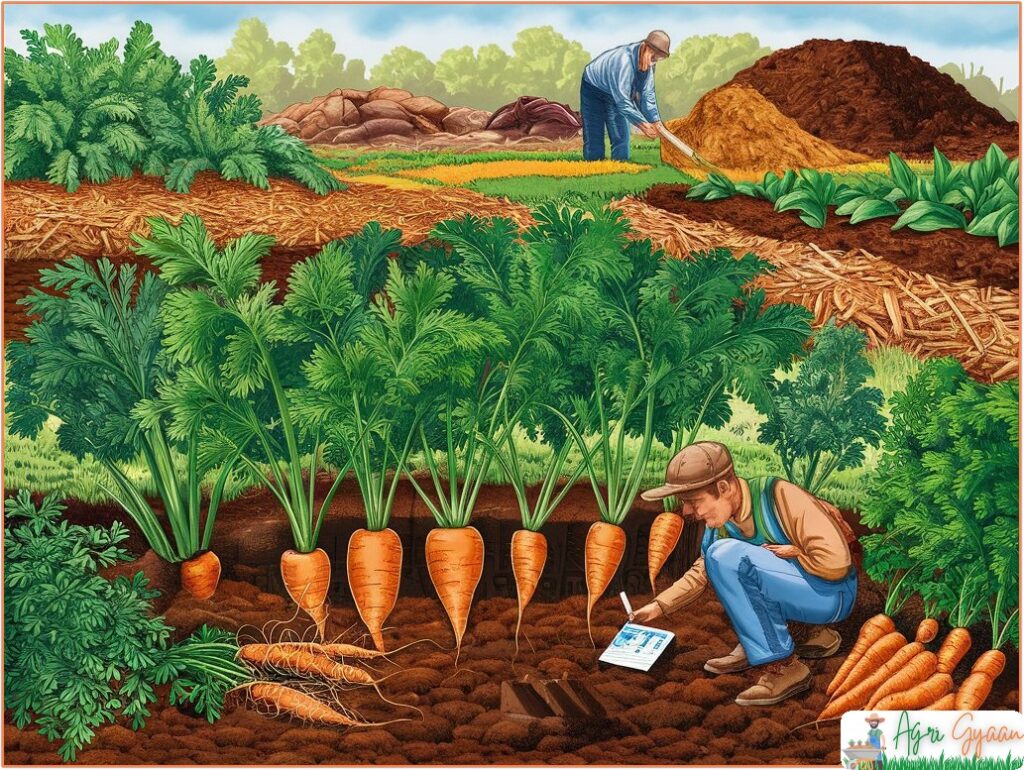
Natural fertilization is essential for growing healthy and nutritious carrots without relying on synthetic chemicals. Here are some effective natural fertilization techniques:
1. Soil Testing
– Initial Testing: Conduct a soil test to determine the nutrient levels and pH of your soil. This will help you understand the specific needs of your garden and guide your fertilization plan.
– Periodic Testing: Test the soil periodically to monitor nutrient levels and adjust your fertilization practices as needed.
2. Organic Matter
– Compost: Incorporate well-rotted compost into the soil before planting. Compost improves soil structure, enhances moisture retention, and provides a slow-release source of nutrients.
– Aged Manure: Use aged or composted manure to add organic matter and essential nutrients. Ensure the manure is well-rotted to avoid burning the plants and to minimize weed seeds.
3. Green Manures and Cover Crops
– Cover Crops: Plant cover crops like clover, vetch, or rye in the off-season. These crops add organic matter, improve soil structure, and fix nitrogen in the soil.
– Green Manures: Turn cover crops into the soil as green manure before planting carrots. This adds valuable nutrients and organic matter to the soil.
4. Mulching
– Organic Mulch: Apply a layer of organic mulch, such as straw, grass clippings, or shredded leaves, around the carrot plants. Mulch helps retain moisture, suppress weeds, and gradually decomposes to add nutrients to the soil.
5. Natural Fertilizers
– Compost Tea: Brew compost tea by steeping compost in water for several days. Use the resulting liquid to water your carrot plants, providing them with a nutrient-rich boost.
– Fish Emulsion: Dilute fish emulsion with water according to the manufacturer’s instructions and apply it as a foliar spray or soil drench. Fish emulsion is high in nitrogen and other essential nutrients.
– Seaweed Extract: Use seaweed extract as a foliar spray or soil drench. It provides trace minerals, vitamins, and growth hormones that promote healthy plant growth.
6. Nutrient-Rich Amendments
– Bone Meal: Add bone meal to the soil to provide a slow-release source of phosphorus, which is essential for root development.
– Wood Ash: Use wood ash sparingly to raise soil pH and add potassium. Ensure it is free from chemicals and applied in moderation.
– Epsom Salt: Dissolve Epsom salt in water and apply it to the soil to supply magnesium, which is crucial for photosynthesis and enzyme function.
7. Crop Rotation
– Rotational Planting: Rotate your carrot crops with legumes (e.g., peas, beans) to naturally increase soil nitrogen levels. Legumes fix nitrogen in the soil, benefiting subsequent carrot crops.
– Avoid Replanting: Avoid planting carrots in the same spot year after year to reduce the risk of soil-borne diseases and nutrient depletion.
8. Companion Planting
– Beneficial Plants: Plant carrots alongside companion plants such as onions, leeks, and garlic. These plants can help deter pests and improve soil health.
– Nitrogen-Fixing Plants: Interplant with legumes to enhance nitrogen availability in the soil.
Pest and Disease Management
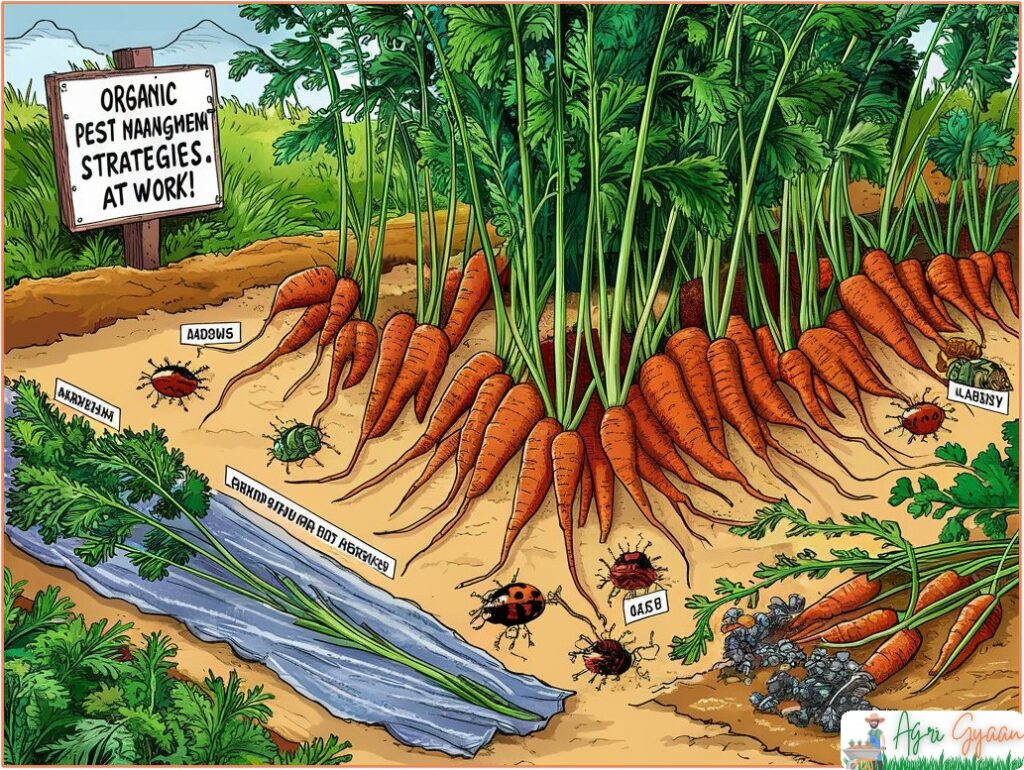
Effective pest and disease management is essential for growing healthy carrots. Using natural and organic methods can help maintain a balanced ecosystem in your garden. Here are strategies for managing common carrot pests and diseases:
1. Pest Management
A. Carrot Root Fly
– Symptoms: Stunted growth, yellowing leaves, and tunnels in the roots.
– Prevention:
– Use floating row covers to prevent adult flies from laying eggs.
– Practice crop rotation and avoid planting carrots in the same spot each year.
– Sow seeds thinly to reduce the need for thinning, which attracts flies.
– Control:
– Companion planting with onions, leeks, or chives to deter flies.
– Apply beneficial nematodes (Steinernema carpocapsae) to the soil to target larvae.
B. Aphids
– Symptoms: Distorted leaves, sticky honeydew, and sooty mold.
– Prevention:
– Encourage beneficial insects like ladybugs and lacewings.
– Avoid over-fertilizing with nitrogen, which can attract aphids.
– Control:
– Spray with a solution of water and a few drops of insecticidal soap or neem oil.
– Use strong water jets to dislodge aphids from plants.
C. Cutworms
– Symptoms: Seedlings cut off at the soil line.
– Prevention:
– Place collars around young seedlings to protect them.
– Remove plant debris and weeds where cutworms may hide.
– Control:
– Handpick cutworms at night when they are active.
– Apply diatomaceous earth around plants as a barrier.
D. Carrot Weevil
– Symptoms: Brown tunnels in the roots and stunted growth.
– Prevention:
– Rotate crops and avoid planting carrots near previous year’s carrot beds.
– Use row covers to prevent adult weevils from laying eggs.
– Control:
– Handpick and destroy adult weevils.
– Apply beneficial nematodes to the soil to target larvae.
2. Disease Management
A. Alternaria Leaf Blight
– Symptoms: Dark brown spots on leaves with yellow halos.
– Prevention:
– Plant disease-resistant carrot varieties.
– Avoid overhead watering to reduce leaf wetness.
– Control:
– Remove and destroy infected plant debris.
– Apply copper-based fungicides if necessary.
B. Powdery Mildew
– Symptoms: White, powdery growth on leaves and stems.
– Prevention:
– Ensure good air circulation by spacing plants adequately.
– Avoid watering in the evening.
– Control:
– Apply a mixture of water and baking soda (1 teaspoon per quart of water) to affected plants.
– Use sulfur-based fungicides if necessary.
C. Root Knot Nematodes
– Symptoms: Swollen, galled roots and stunted growth.
– Prevention:
– Rotate crops with non-host plants like cereals and grasses.
– Use resistant carrot varieties.
– Control:
– Apply beneficial nematodes to target root knot nematodes.
– Incorporate organic matter to encourage beneficial soil organisms.
D. Damping-Off
– Symptoms: Seedlings collapse and die soon after germination.
– Prevention:
– Use sterilized soil and clean containers for starting seeds.
– Avoid overwatering and ensure good drainage.
– Control:
– Apply a biological fungicide containing Trichoderma or Bacillus subtilis.
– Use cinnamon powder or chamomile tea as a natural antifungal treatment.
3. Cultural Practices
– Crop Rotation: Rotate carrot crops with non-host plants to prevent the buildup of pests and diseases in the soil.
– Sanitation: Remove plant debris and weeds that can harbor pests and diseases.
– Healthy Soil: Maintain healthy soil with adequate organic matter and proper pH levels to support robust plant growth.
– Companion Planting: Plant carrots with companion plants like onions, garlic, and marigolds to deter pests and improve overall plant health.
4. Monitoring and Early Detection
– Regular Inspection: Check your carrot plants regularly for signs of pests and diseases.
– Prompt Action: Take immediate action at the first signs of trouble to prevent the spread of pests and diseases.
Harvesting Tips

Harvesting carrots at the right time and in the right way ensures that you get the best flavor, texture, and nutritional value from your crop. Here are some tips to help you harvest carrots effectively:
1. Timing the Harvest
– Days to Maturity: Carrot varieties have different days to maturity, typically ranging from 60 to 80 days. Check the seed packet for specific information about your variety.
– Size and Color: Carrots are usually ready to harvest when they have reached the desired size and color. The tops of the carrots should be about 1/2 to 1 inch in diameter.
– Taste Test: For the best flavor, you can pull up a test carrot to check its size and taste. If it’s sweet and tender, the rest of the crop is likely ready.
2. Harvesting in Stages
– Successive Harvests: For a continuous supply, sow carrot seeds in succession every 2-3 weeks and harvest in stages as the carrots reach maturity.
– Staggered Harvesting: If you planted a large batch, consider harvesting carrots over several weeks to enjoy fresh carrots longer and to allow smaller ones to continue growing.
3. Preparing the Soil
– Watering Before Harvest: Water the soil a day before harvesting to soften it. This makes it easier to pull the carrots out without breaking them.
– Loosening Soil: Use a garden fork or spade to gently loosen the soil around the carrots, being careful not to damage the roots.
4. Harvesting Techniques
– Pulling by Hand: Grasp the carrot tops firmly at the base and pull straight up. If the soil is properly loosened, the carrots should come out easily.
– Using Tools: If the carrots are difficult to pull by hand, use a garden fork to lift them gently. Insert the fork a few inches away from the carrot row to avoid spearing the roots, and carefully lift the soil and carrots together.
5. Post-Harvest Handling
– Removing Tops: Cut off the green tops about 1/2 inch above the root to prevent them from drawing moisture and nutrients away from the carrot. This helps keep the carrots fresh longer.
– Cleaning: Brush off excess soil from the carrots. Avoid washing them until you are ready to use them to prolong storage life.
– Sorting: Sort out any damaged or split carrots and use these first, as they won’t store as well as intact ones.
6. Storage
– Refrigeration: Store carrots in the refrigerator in a plastic bag with a few air holes to keep them fresh for several weeks.
– Root Cellar: If you have a root cellar, carrots can be stored in sand or sawdust in a cool, dark place with high humidity.
– Freezing: For long-term storage, carrots can be blanched and frozen. Slice or chop them before blanching for easy use later.
7. Protecting Late Harvests
– Frost Protection: Carrots can tolerate light frost and may even become sweeter after a frost. However, for late-season carrots, cover the rows with straw or leaves to protect them from heavy frost and freezing temperatures.
– Mulching: If you plan to leave carrots in the ground for winter harvesting, apply a thick layer of mulch to insulate the soil and prevent freezing.
8. Baby Carrots
– Early Harvest: For baby carrots, harvest when they are young and tender, usually when they are about the thickness of a finger.
– Thinning: Thin out crowded plants early, and use these thinnings as baby carrots.
Storing Carrots

Proper storage techniques ensure that your harvested carrots remain fresh, crisp, and nutritious for an extended period. Here are some effective methods for storing carrots:
1. Preparing Carrots for Storage
– Remove Tops: Cut off the green tops about 1/2 inch above the root. The tops draw moisture from the carrots, causing them to wilt and become limp.
– Cleaning: Brush off any excess soil, but avoid washing the carrots before storage to prevent moisture buildup, which can lead to rot.
2. Short-Term Storage
– Refrigeration: Place the carrots in a plastic bag with a few air holes to maintain moisture without trapping too much condensation. Store the bag in the crisper drawer of your refrigerator. Carrots stored this way can last for several weeks.
3. Long-Term Storage
– Root Cellar: If you have a root cellar, it’s an ideal place for storing carrots. Ensure the cellar is cool (32-40°F or 0-4°C) and has high humidity (90-95%).
– In Sand or Sawdust: Layer the carrots in a box or bin with damp sand, sawdust, or peat moss. Ensure the carrots are not touching each other to prevent rot. Cover each layer with the medium and continue layering until the box is full.
– Loose Storage: Alternatively, you can store carrots loosely in bins or crates in the root cellar, ensuring good air circulation.
– Outdoor Pit Storage: In regions with mild winters, you can store carrots in a pit dug in the ground. Line the pit with straw or leaves, place the carrots in it, and cover them with more straw or leaves and a layer of soil. This method insulates the carrots from freezing temperatures.
4. Freezing Carrots
– Blanching: Wash, peel, and cut the carrots into slices, cubes, or sticks. Blanch the carrot pieces in boiling water for 2-3 minutes, then immediately transfer them to an ice water bath to stop the cooking process.
– Drying and Packaging: Drain the carrot pieces thoroughly and pat them dry. Pack the blanched carrots into airtight freezer bags or containers, removing as much air as possible. Label and date the packages before placing them in the freezer.
– Storage Duration: Frozen carrots can be stored for up to a year, retaining their flavor and nutritional value.
5. Fermenting Carrots
– Fermentation Process: Fermenting carrots is another way to preserve them. Wash and cut the carrots into sticks or slices. Place them in a clean jar and cover them with a brine solution (2 tablespoons of salt dissolved in 1 quart of water). Weigh the carrots down to keep them submerged and cover the jar with a cloth or loose lid to allow gases to escape.
– Fermentation Time: Allow the carrots to ferment at room temperature for 1-2 weeks, then transfer the jar to the refrigerator. Fermented carrots can last for several months and offer a tangy, probiotic-rich snack.
6. Drying Carrots
– Dehydrating: Slice the carrots thinly and spread them on dehydrator trays. Dry at 125°F (52°C) for 6-10 hours until they are completely dry and brittle.
– Storage: Store dried carrots in airtight containers in a cool, dark place. Properly dried and stored carrots can last for up to a year.
7. Canning Carrots
– Pressure Canning: Wash, peel, and cut the carrots into uniform pieces. Pack the carrots into sterilized jars, leaving 1 inch of headspace. Add boiling water to cover the carrots, then process the jars in a pressure canner according to the manufacturer’s instructions. – Storage: Store canned carrots in a cool, dark pantry. Properly canned carrots can last for up to a year or more.
